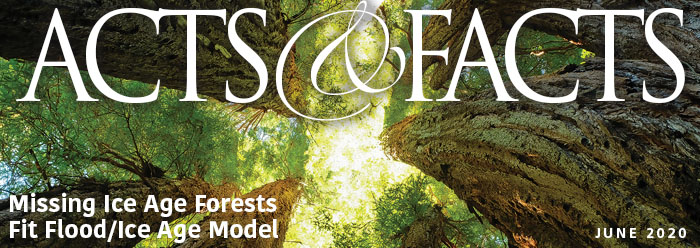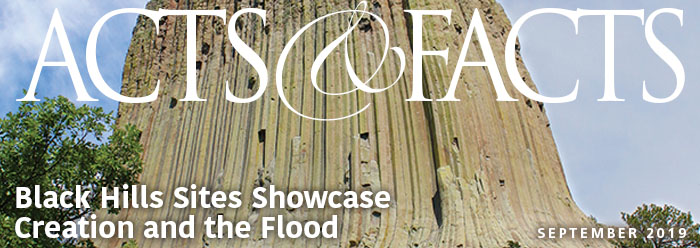Genesis claims that people in the pre-Flood world routinely attained 900-year lifespans. The best-known example is Methuselah, who had the longest recorded lifespan of 969 years (Genesis 5:27). Skeptics dismiss these great ages as fanciful legends, but recent fossil data are providing unexpected, albeit indirect, corroboration of the Bible’s testimony. Science Advances reports that growth patterns in fossil teeth show that seven small shrew- and mouse-like Jurassic mammals all had very long lifespans compared to living mammals of comparable size.1 The seven colored squares in the above figure show that these lifespans are generally much longer than the lifespans of living (extant) mammals of the same body mass (solid black dots and red trend line).2
A previous Creation Science Update article described how scientists had already found evidence for “surprisingly long” lifespans in the fossil teeth of the three Jurassic mammal genera Krusatodon, Morganucodon, and Kuehneotherium.3,4 In addition to summarizing these previous results, this new paper presented evidence of greater longevity for three more genera of Jurassic mammals—Borealestes, Haldanodon, and Dryolestes—as well as an unidentified small multituberculate mammal.1,5
Nearly all the sedimentary rocks and fossils were formed during the year-long Noahic Flood described in Genesis 6–8. Thus, the long lifespans of these seven small Jurassic mammals are direct evidence that mammals living in the pre-Flood world experienced greater longevity, not unlike Methuselah and his contemporaries.
Paleobiologist Elsa Panciroli, the lead author on a recent paper in Nature6 discussing the longevity of the mouse-like Krusatodon, commented:
“Recent work has already shown that the first mammals in the Late Triassic and Early Jurassic lived much longer than similar sized mammals today – up to 14 years old. If you compare that with today’s shrews of similar body mass, some of which live to just over a year, this is a huge difference in lifespan.”7
The Bible gives no indication that this remarkable pre-Flood longevity was supernatural or miraculous. Rather, such longevity seems to have been perfectly normal in the pre-Flood world. Creationists have suggested a number of possible causes for pre-Flood human longevity (fewer genetic mutations, different atmospheric composition, abundant food, etc.), but any such mechanism or mechanisms would likely have increased animal longevity, too. Pre-Flood animal genomes, like the genomes in pre-Flood humans, likely accumulated far fewer genetic mistakes compared to today’s animals and humans. Both pre-Flood humans and animals were breathing the same air, and both pre-Flood humans and animals likely had access to abundant food, etc. Thus, it is very likely that animals in the pre-Flood world were also experiencing much greater longevity. These results are consistent with that expectation, as is direct evidence of greater longevity in fossil Crassostrea oysters.1,8 Moreover, I presented preliminary evidence at the 2023 International Conference on Creationism that bivalve mollusks from Antarctica were also experiencing extreme longevity.9
These fossil data corroborate the book of Genesis in another way. They show that the Dryolestes and multituberculate mammal were taking longer to reach sexual maturity, as did an undetermined Dryolestoid mammal and a small mammal belonging to the genus Palaeoxonodon.1 Fossil shark data also show evidence of delayed maturation, and there is some preliminary evidence that the same was true for at least some fossil birds.9,10 These results are intriguing in light of Genesis 5. Mahalaleel and Enoch were 65 years old at the births of their sons (Genesis 5:15, 21), and Cainan was 70 years old (Genesis 5:12). These are the very youngest recorded ages at which a Genesis 5 patriarch is listed as having a son. Although it is likely not all of these sons were firstborns, it is likely that at least some of them were. The advanced ages of these fathers strongly suggest delayed sexual maturation, since it is difficult to imagine pre-Flood humans experiencing puberty at 13 and then routinely choosing to wait 50+ years to have children!
So it seems that pre-Flood humans and at least some pre-Flood animals were experiencing delayed sexual maturation in addition to extreme longevity. This makes sense in light of studies showing that larger adult body sizes and delayed skeletal and sexual maturation are often associated with greater longevity in living animals.9 However, because these Jurassic mammals are presumably extinct, we don’t know if they would have been larger than any of their hypothetical post-Flood descendants. However, evidence for giantism is abundant in fossils,9,11 and we know that mammals apparently underwent a worldwide reduction in body size at the end of the post-Flood Ice Age, 12,13 at a time that human lifespans were decreasing (Genesis 11).
We at ICR are excited by these results,14 which should be of great encouragement to Bible-believing Christians. Despite opposing claims by some, the remarkable longevities recorded in the early chapters of Genesis are literal history, not symbolic or mythical, and scientific evidence is accumulating that this longevity characterized not just pre-Flood people but also many pre-Flood animals.
References
- Newham, E. et al. 2024. The Origins of Mammal Growth Patterns during the Jurassic Mammalian Radiation. Science Advances. 10 (32): eado4555.
- The chart is a logarithmic graph, in which the number on each tick mark is 10 times greater than the number on the previous tick mark. This is a convenient way to depict data spread over a very large range in values without the need for a ridiculously large graph.
- Hebert, J. Do Tiny Mammal Fossils Corroborate Pre-Flood Longevity? Creation Science Update. Posted on ICR.org August 15, 2024, accessed September 5, 2024.
- Baisas, L. Baby Teeth Reveal Surprisingly Long Lifespans of Small Jurassic Mammals. Popular Science. Posted on popsci.com July 24, 2024, accessed September 5, 2024.
- A multituberculate is an extinct rodent-like mammal whose cheek teeth have multiple rows of cusps, or tubercles.
- Panciroli, E. et al. 2024. Jurassic Fossil Juvenile Reveals Prolonged Life History in Early Mammals. Nature. 632 (8026): 815–822.
- Schuster, R. Early Mammals Lived Longer. Why Can’t We? Haaretz. Posted on haaretz.com July 24, 2024, accessed July 26, 2024.
- Hebert, J. 2024. Oysters and Pre-Flood Longevity. Acts & Facts. 53 (5): 19.
- Hebert III, L. 2023. Allometric and Metabolic Scaling: Arguments for Design . . . and Clues to Explaining Pre-Flood Longevity? Proceedings of the International Conference on Creationism. 9, article 18.
- Hebert, J. 2024. Fossil Sharks Show Signs of Greater Past Longevity. Acts & Facts. 53 (5): 20.
- Nelson, V. 2017. Untold Secrets of Planet Earth: Monumental Monsters. Red Deer, Alberta, CA: Untold Secrets of Planet Earth Publishing Co.
- Hebert, J. 2024. Late Pleistocene Body Size Reduction: Evidence of a Post-Flood Decline in Longevity? Journal of Creation. 38 (1): 60–66.
- Davis, S. J. M. 1981. The Effects of Temperature Change and Domestication on the Body Size of Late Pleistocene to Holocene Mammals of Israel. Paleobiology. 7 (1): 101–114.
- Dusseau, R. Interview with Jake Hebert, Ph.D. Living for a Millennium?! The Creation Podcast. Episode 80. Uploaded August 27, 2024.
Stage image credit: Copyright © Elis Newham et al. Figure 3.A, reference 1. CC BY-4.0. Used in accordance with federal copyright (fair use doctrine) law. Usage by ICR does not imply endorsement of copyright holder.
* Dr. Jake Hebert is a research associate at the Institute for Creation Research and earned his Ph.D. in physics from the University of Texas at Dallas.







